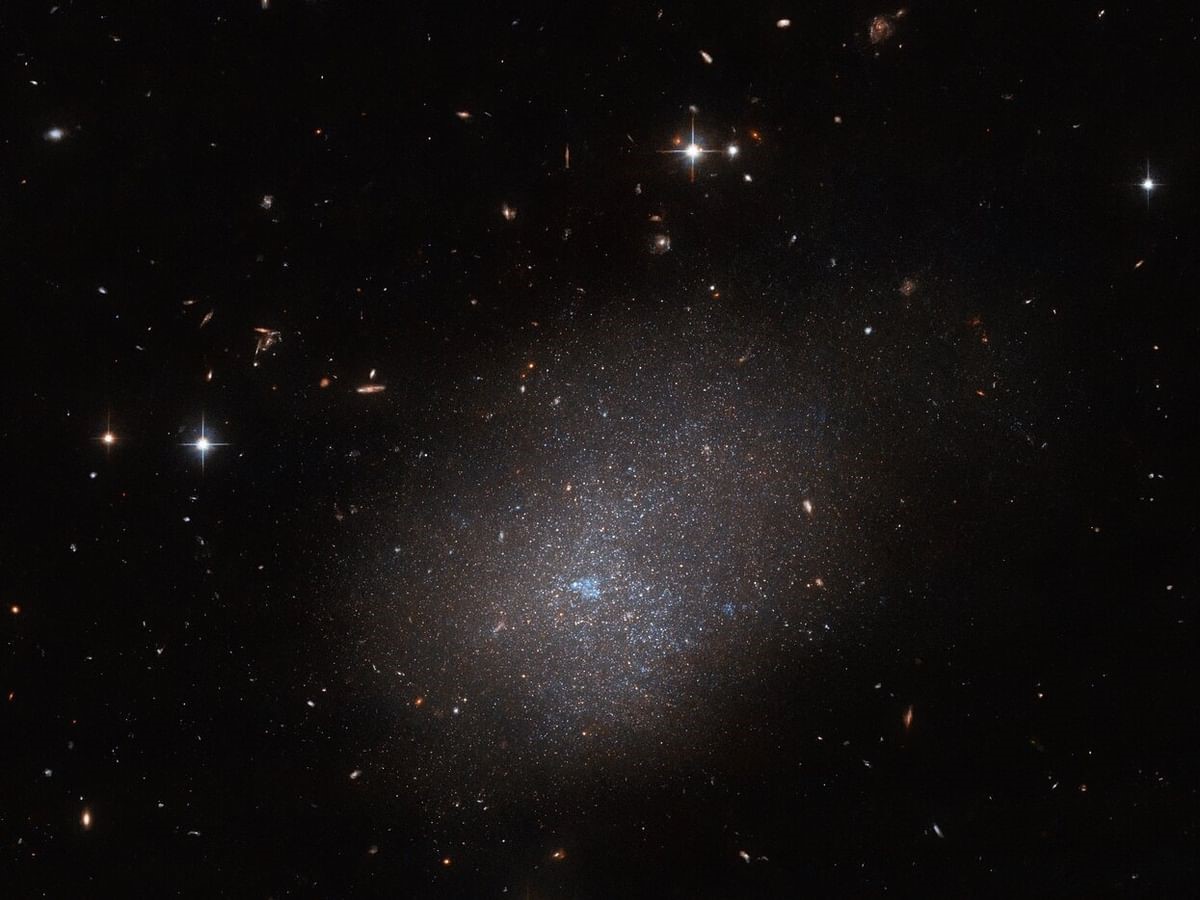Description

Disclaimer: Copyright infringement not intended.
Context
- The Hubble Space Telescope has snapped a stunning image of a galaxy that defies classification.
- ESO 300-16 is an irregular galaxy, a type of galaxy that lacks a clear shape and structure.
- The galaxy is located in the constellation of Eridanus, contains a bubble of blue gas at its core and has a backdrop of many distant galaxies.
Details
Galaxy Characteristics
Irregular Galaxy
- ESO 300-16 is categorized as an irregular galaxy due to its lack of a clear and organized structure.
- Unlike spiral or elliptical galaxies, irregular galaxies do not adhere to the typical symmetrical shapes often associated with galaxies.
Distinctive Features
- The galaxy exhibits a bubble of bright blue gas at its core, which adds to its distinctive appearance.
- This gas bubble contributes to the overall uniqueness of ESO 300-16 within the realm of irregular galaxies.
Hubble's Observation
Hubble Space Telescope's Role
- The image of ESO 300-16 was captured by the Hubble Space Telescope, a renowned deep space observatory known for its high-resolution and detailed images of celestial objects.
- The telescope's capabilities allow for the capture of distant galaxies and their intricate details.
Every Known Nearby Galaxy Campaign
- The observation of ESO 300-16 is part of the "Every Known Nearby Galaxy" campaign.
- This initiative aims to create a comprehensive inventory of Hubble images of galaxies located within a specific distance from Earth.
- ESO 300-16 is among the galaxies targeted by this campaign.

Significance and Research
Studying Irregular Galaxies
- Observing irregular galaxies like ESO 300-16 contributes to our understanding of galactic evolution, formation, and interactions.
- Their unique structures provide insights into the complex processes that shape the universe.
Scientific Insights
- By analyzing the features and properties of ESO 300-16, astronomers can gain valuable information about the dynamics of irregular galaxies.
- The presence of the blue gas bubble and the overall structure of the galaxy offer clues about its history and current state.
Overview of Irregular Galaxies
Characteristics of Irregular Galaxies
Lack of Structured Form:
- Irregular galaxies stand out due to their absence of a well-defined structure.
- Unlike spiral galaxies with their distinct arms or elliptical galaxies with smooth ellipsoidal shapes, irregular galaxies exhibit irregularities in their shapes, sizes, and distributions of stars.
Diverse Subtypes:
- Irregular galaxies can be further classified into two subtypes: Irr I and Irr II.
- Irr I galaxies have more organized regions of star formation, while Irr II galaxies lack such concentrated regions, appearing more chaotic in nature.
Formation and Evolution
Dynamic Interactions:
- The irregular shapes of these galaxies often result from interactions with other galaxies or gravitational forces disrupting their structure.
- These interactions can trigger bursts of star formation, leading to pockets of intense luminosity within an otherwise irregular appearance.
Stellar Activity:
- Irregular galaxies are characterized by active star-forming regions.
- The absence of clear patterns allows stars to form in diverse areas, leading to a range of ages and types of stars within the galaxy.
- This dynamic stellar activity contributes to the irregular appearance.
Significance for Astronomical Research
Galactic Evolution:
- Studying irregular galaxies provides valuable insights into galactic evolution.
- The irregularities observed today may have originated from interactions, mergers, or gravitational disturbances that occurred over millions of years.
- By analyzing these galaxies, astronomers can piece together their histories.
Star Formation Studies:
- Irregular galaxies offer a unique laboratory for studying star formation processes in extreme environments.
- The diverse locations and conditions within these galaxies allow scientists to explore the factors influencing star birth and its impact on the galactic ecosystem.
Observations and Discoveries
Hubble's Contributions:
- The Hubble Space Telescope and other advanced observatories have enabled detailed observations of irregular galaxies.
- High-resolution images reveal intricate details of their irregular structures, enhancing our understanding of their dynamics and evolution.
Examples of Irregular Galaxies:
- Notable examples of irregular galaxies include the Large and Small Magellanic Clouds, which are satellites of the Milky Way.
- These galaxies exhibit irregular shapes due to their interactions with our own galaxy.
.jpg)
Conclusion
The Hubble Space Telescope's image of irregular galaxy ESO 300-16 sheds light on the intricate and diverse nature of galaxies in the cosmos. Through initiatives like the Every Known Nearby Galaxy campaign, Hubble continues to expand our understanding of the universe by capturing captivating images and contributing to scientific research.
|
PRACTICE QUESTION
Q. Discuss the significance of irregular galaxies in the field of astronomy and astrophysics. How do their unique characteristics and dynamic nature contribute to our understanding of galactic evolution and the processes shaping the universe? (250 Words)
|
https://www.news9live.com/science/hubble-space-telescope-captures-image-of-irregular-galaxy-eso-300-16-2257909











